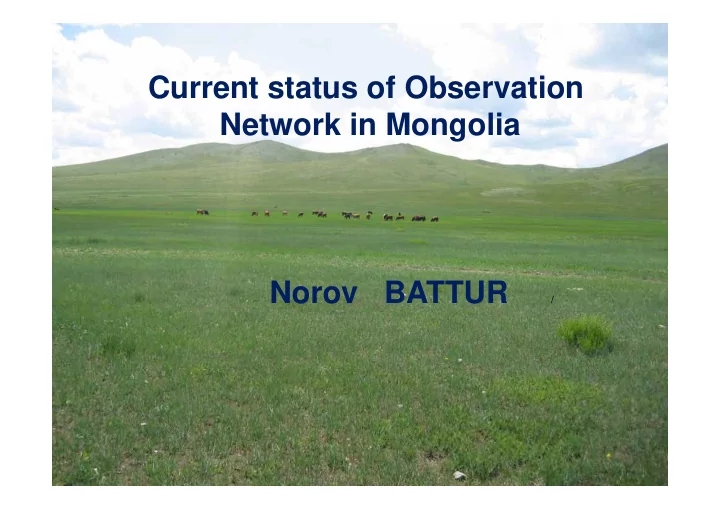

C Current status of Observation t t t f Ob ti Network in Mongolia g Norov BATTUR /
Short History Meteorological and Hydrological Services of Mongolia are functioning officially since 1936 when the first meteorological g y g observation stations were established in the country. But several meteorological observation stations operated since 1986 in capital city in Ulaanbaatar, and some other i 1986 i it l it i Ul b t d th administrative centers of Mongolia. Mongolia Mongolia has has joined joined to to the the World World Meteorological Meteorological Organization in 1963. The National Agency g y for Meteorology gy and Environment Monitoring /NAMEM/, is the government’s implementing agency. The agency provides information of weather forecasting, hydro-meteorology h d t l and d environmental i t l condition diti t to governmental and private organizations, coordinates all hydro- meteorological observation networks of Mongolia meteorological observation networks of Mongolia.
Meteorological Organizational structure National Agency for Meteorology and Environmental Monitoring Institute of Meteorology and Institute of Meteorology and Information and Computer Center Hydrology Central laboratory for Province centers Instruments and Environmental Monitoring Aviation Meteorological Center Weather Modification Center
Structure of the NAMEM Director ‐ General Division of State Strategy and International Division of Administration Archive and Planning g Cooperation p Finance and Finance and Division Division Database Center Division Division Economy
Observation Network Currently there are 130 meteorological stations, 186 meteorological posts, 3 upper ‐ air stations in observation network of NAMEM. Meteorological observation field Meteorological observation field Location of meteorological Location of meteorological stations
The observed variables in all meteorological stations: The observed variables in all meteorological stations: Air temperature, surface soil temperature, atmospheric p p pressure, humidity, y wind velocity y and direction, precipitation /amount and intensity/, cloud amount and type, visibility, weather /present and past/, snow depth and density. d th d d it In addition to these variables mentioned above, some meteorological stations observe solar radiation sunshine meteorological stations observe solar radiation, sunshine duration, deep soil temperature, soil moisture, evaporation. p There are 70 manned stations in meteorological observation network. We supply instruments to all observation stations and purchase mostly observation b ti t ti d h tl b ti instruments from Russian and China .
Our Agency is intending to install automatic meteorological station at all observation stations, g but we have difficulty is financial problems. Therefore, this plan greatly depends on Mongolian economics and finance. Present, about 60 automatic meteorological stations operated since 2000 in our meteorological observation network, 30 of the stations have been set up in 2008. Types of automatic meteorological stations in our observation network: MAWS301, SK4100, CAMS630, QLI50.
Table 1. number of stations RBSN RBCN GSN Manned AWS stations stations 1 130 130 - 70 60
All meteorological stations are making synoptic and c climate ate observations obse at o s 8 8 times t es per pe day. day Local oca meteorologists and technicians use mobile, internet, VSAT to transfer observation data. National Meteorological Telecommunication Network has two GTS lines with WMO Regional Meteorological Centers in Novosibirsk Centers in Novosibirsk, Russia and Beijing, China and Russia and Beijing China and twenty local lines with local centers through VSAT. Above given, there are a lot of manned station in g , meteorological observation network since it’s necessary to check observation data. Therefore, Local meteorologists check first observation data in province meteorological center.
Climate section in the Institute of the Hydrology and Meteorology make last control y gy gy of observation data along specific instruction and transfer checked data to center of data base. It’s different series of observation data in ever station and have over 70 years observation data in the oldest stations . All observation data are stored in database center of NAMEM.
About training NAMEM is responsible for f training activities for meteorologists and meteorologists and technicians of observation network. We organize special g p trainings for different fields such as meteorology, agro- meteorology, hydrology and t l h d l d environmental monitoring. The used types of training: The used types of training: lecture, discussion, practice, e-learning. g Lecture rooms of the Training center.
Some observers of the observation network are not graduated from special college for this observation. So every year we organize short y y g training / 1 month/ course for them and they obtained a certificate. Also last few years we y have installed several types of automatic weather stations. So we need specialized p technicians and engineers. In the future we would like to extend our training activities to cooperate other international and regional training centers It will be very important to other international and regional training centers. It will be very important to improve their skills and knowledge for our meteorologists and engineers.
There is a need to improve meteorological observation networks of meteorological observation networks of the country. Our main goal is: • improve skills of meteorologists and • improve skills of meteorologists and technicians • Improve quality of observational data • Improve quality of observational data. • Improve quality technologies and techniques techniques.
Thank you for your attention Thank you for your attention
Recommend
More recommend